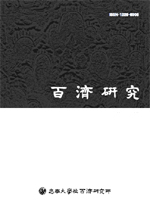중도식무문토기의 기종·기형·기술
Forming Procedures and Morphological Variations in the Jung-do Style Ceramic Assemblages
- 충남대학교 백제연구소
- 백제연구
- 제77집
-
2023.02129 - 158 (30 pages)
- 505

이 논문은 북한강 유역 원삼국·삼국시대 취락에서 사용되었던 중도식무문토기군의 형태적 변이에 관한 연구이다. 일정 토기유물복합체는 그릇의 전체적인 규격과 외형에 따라 용도를 달리하는 기종이 일차적으로 분화되고 각 기종의 세부 형태나 문양 장식에 따라 기형이 분화된다고 흔히 받아들여 왔다. 중도식무문토기군도 당연히 여러 기종으로 분화되는 것이 사실이지만, 구분의 경계가 모호하다. 각각의 기종이 형태 변화의 어떤 경향이 있는 것도 분명하나, 형식을 분류하여 그것을 시기적으로 배열하는 작업은 어렵다고 알려져 있다. 중도식무문토기군의 그릇은 형태적으로 단순하고, 기종 간 변이가 연속적이며, 형식의 변이가 시기-지역에 따라 잘 정리되지 않는 특징을 보인다. 그러함에도 이 논문에서는 중도식무문토기의 형태적 변이를 이해해보기 위해 일정 시기 토기군을 대, 중, 소의 규격에 따라 1차 구분하고, 이 1차 분류군을 각각 주성분 분석법(Principal Component Analysis)으로 분석하여 일정한 크기의 그릇이 형태적으로 어떻게 구분되는지를 살폈다. 이와 같은 중도식무문토기의 형태적 변이에 대한 분석을 통해 일정 시기에 기종이 분화되는 양상과 각 기종의 형태가 변해가는 경향성을 파악하고 그러한 형태적 변이를 성형의 작업연쇄와 관련지어 설명해 보았다. 중도식무문토기군의 형태적 변이에는 하나의 중요한 특성이 있는데 여러 기종 사이에 공유된 형태가 존재한다는 것이다. 이는 중도식무문토기 완, 발, 옹, 대형옹, 혹은 대호 등을 한 도공이 제작할 때 그가 공통으로 적용한 체화된 성형 작업연쇄 때문이라고 생각된다. 또한 중도문화지역에는 중도식무문토기와 타날문토기 두 가지 생산체계가 오랫동안 상호작용하면서 공존해왔던 것이 중도식무문토기의 형태적 변이에 영향을 주었다. 중도식무문토기의 도공들은 타날문토기의 기종을 모방·제작하거나, 물레질-타날법의 기술 체계의 일부 요소를 자신의 성형 작업연쇄에 끼워 넣어 기물을 생산하였기에 그릇의 형태에 변이가 발생하기도 했다.
This study is an approach to the morphological variation of the Jung-do style Mumun ceramic assemblage used in villages during the early historical period of the Bukhangang River basin. In certain ceramic assemblage, it could be primarily divided into classes depending on the size and overall morphology, and the vessels belonging to each class be classified into several types according to detailed forms or decorations. Jung-do style ceramic assemblages could also be divided into several classes, but the boundaries of the division are ambiguous. Although each type of vessels shows a tendency to change over space-time, it is difficult to define a clear difference. The Jung-do style Mumun vessels are simple in form, the variations between them are continuous, and the differences in types are not well organized according to the time-space. In this paper, a statistical analysis was attempted to understand the morphological variation in the Jung-do style Mumun ceramic assemblage. First, we first classified Jung-do style Mumun vessels from a certain period according to the differentiation of size. Secondly, we analyzed each pre-classified group of vessels using a Principal Component Analysis(PCA) to examine the morphological variations of vessels of a certain size. As a result of the analysis, we suggested that the morphological variation of the groups of vessels and the shape shared across the classes of vessels could be explained by its own unique forming procedure. And we pointed out that the potter of the Mumu-ware interacted with the wheel-throwing technician who coexisted with him and adopted some elements of the new technological system, and the new forming Chaîne Opératoire changed the shape of the vessels.
Ⅰ. 머 리 말
Ⅱ. 문제의 제기와 분석의 방법
Ⅲ. 중도식무문토기의 형태 분석
Ⅳ. 성형기술과 기종·기형의 상관성
Ⅴ. 맺 음 말
(0)
(0)